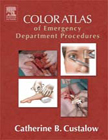|
|
|
| |
 |
|
|

|
 推薦指數:
推薦指數:





|
|
- 內容介紹
|
Color Atlas of Emergency Department Procedures
By Catherine Custalow, MD, PhD
224 pages, 574 ills,
Trim size 8 1/2 X 10 7/8 in,
Copyright 2004
Description
This brand-new book offers virtual hands-on experience to over 65 emergency procedures, allowing readers to rehearse them over again in their mind—then perform them on demand correctly. Inside, they'll find color drawings of each procedure that illuminate relevant anatomical structures and their relationship to each new step paired with full-color photographs that provide a realistic clinical view of the identical anatomy. Plus, each step is accompanied by concise text, allowing the illustrations and photographs to guide clinicians effortlessly through the procedure.
Key Features
Presents step-by-step, side-by-side full-color illustrated guidance.
Uses a standard chapter organization for quick reference.
Offers a brief description of each procedure.
Features bulleted lists of clinical indications, oft-overlooked contraindications, and potential complications.
Displays the essential equipment needed to perform the procedure.
And more.
Table of Contents
CHAPTER 1: Arthrocentesis
A. Arthrocentesis of Knee B. Arthrocentesis of Ankle C. Arthrocentesis of Elbow
CHAPTER 2: Central Vein Catheterization
A. Anatomical Approaches for Central Vein Catheterization 1. Subclavian Vein-Infraclavicular Approach 2. Subclavian Vein-Supraclavicular Approach 3. Internal Jugular Vein-Central Approach 4. Internal Jugular Vein-Posterior Approach 5. Femoral Vein Approach B. The Seldinger technique
CHAPTER 3: Compartment Pressures
A. Stryker Compartment Pressure Monitoring Device Steps B. Approach for each Anatomical Compartment 1. Forearm Compartments a. Volar Compartment of Forearm b. Dorsal Compartment of Forearm c. Mobile Wad Compartment of Forearm 2. Leg Compartments a. Anterior Compartment of Leg b. Deep Posterior Compartment of Leg c. Superficial Posterior Compartment of Leg d. Lateral Compartment of Leg
CHAPTER 4: Cricothyroidotomy
CHAPTER 5: Diagnostic Peritoneal Lavage
CHAPTER 6: Intraosseous Line Placement
7-Lateral Canthotomy 8-Lumbar Puncture 9-Nerve Blocks of the Face, Head and Oral Cavity A. Inferior Alveolar Nerve Block B. Nerve Blocks of the Palate 1. Anterior Palate 2. Posterior Palate C. Periapical Nerve Block of the Teeth D. Supraorbital Nerve Block E. Infraorbital Nerve Block 1. Extraoral Approach 2. Intraoral Approach F. Mental Nerve Block 1. Extraoral Approach 2. Intraoral Approach G. Nerve Blocks of the Ear H. Nerve Blocks of the Scalp
CHAPTER 10: Nerve Blocks of the Foot
A. Posterior Tibial Nerve Block B. Sural Nerve Block C. Peroneal Nerve Block D. Digital Nerve Block of Toe 1. Lateral Approach 2. Web Space Approach
CHAPTER 11: Nerve Blocks of the Hand
A. Radial Nerve Block B. Median Nerve Block C. Ulnar Nerve Block D. Digital Nerve Block of Finger 1. Lateral Approach 2. Web Space Approach
CHAPTER 12: Ophthalmologic Procedures
A. Shiotz Tonometry B. Tonopen
CHAPTER 13: Paracentesis
CHAPTER 14: Pericardiocentesis
CHAPTER 15: Radial Artery Line Placement
CHAPTER 16: Raney Clip Application
CHAPTER 17: Suprapubic Bladder Aspiration
CHAPTER 18: Thoracentesis
CHAPTER 19: Thoracotomy
CHAPTER 20: Tube Thoracostomy
CHAPTER 21: Venous Cutdown
CHAPTER 22: Wound Care Procedures
A. Preparing the Skin for Wound Repair B. Instrument Tie C. Simple Interrupted Suture D. Continuous Suture E. Continouus Locked Suture F. Horizontal Mattress Suture G. Vertical Mattress Suture H. Deep Suture I. Staple Application J. Staple Removal K. Wound Closure Tape Application
|
|
|

